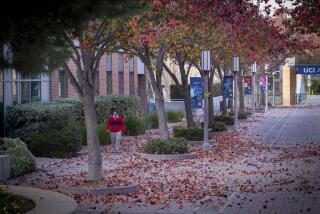CSU Seeks More Funds, New Fee Hike
SACRAMENTO — Over the objections of students and some legislators, Cal State trustees Tuesday approved what administrators admitted was an “extremely optimistic” 1994 budget request that asks more from the state while proposing student fee increases of at least 24% next year.
In presenting the proposal, Chancellor Barry Munitz said he wanted to charge CSU undergraduates $342 and graduate students $432 more a year beginning in 1994 to reverse the effects of three years of deep budget cuts, which have forced the 20-campus system to curtail enrollments, discontinue thousands of classes, reduce its work force, and let maintenance slide for equipment and buildings.
His $2.4-billion budget proposal, which is 16% greater than the current CSU spending plan, is also predicated on the hope that the state will ante up more next year. The trustees voted unanimously to approve the spending plan.
Harold Goldwhite, a CSU Los Angeles professor and chairman of the Academic Senate, voiced support for a plan that he said sends a message to the state, which has been withdrawing funding at a time when the system’s student body is increasingly diverse and its enrollments is expected to zoom.
“I think what this budget is saying is ‘You better look at this again,’ that this is an untenable solution . . . that it’s time to turn this around,” Goldwhite said about the recession-driven dip in state funding.
But lawmakers on the Assembly Higher Education Committee branded plans for student fee hikes as “unconscionable.”
And William Moton, chairman of the California State Student Assn., said students were “really unhappy” with the fee proposal in light of more than 150% in fee increases already enacted since 1989. Moton said it would take a student earning $6 an hour nearly a month’s wages to make up for increases through the current year.
The fee increases would bring undergraduate tuition at CSU to $1,782 a year, nearly 24% more than the $1,440 charged now and more than 150% greater than what a CSU student paid in 1989. About a third of the $124 million raised through the proposed fee hike would go for student financial aid, and the remaining $85 million to an “instructional quality restoration” program to hire 700 more instructors, replace equipment and repair buildings.
The budget will also seek $214 million extra from the state to give faculty and staff members raises of 8% and 5%, respectively. CSU officials also hope to use extra state money to guarantee access to approximately 13,333 more students next year.
Yet CSU administrators admitted during Tuesday’s trustee meeting that their chances of getting everything they seek are slim.
“It is not realistic,” Molly Corbett Broad, executive vice chancellor, said about the proposal. “It is extremely optimistic.”
The 1994 budget also breaks from the 1960 Higher Education Master Plan, which states that the top third of California high school graduates are eligible to attend CSU schools and the top 12.5% are eligible for UC admission.
Traditionally, that commitment has meant money follows enrollment, with the Legislature kicking in the funds to meet student population projections. But the deep recession has seen state funding to CSU campuses shrink by more than $200 million over the last three years, prompting 7,000 classes to be canceled and enrollment to drop by an estimated 40,000 students. The proposed budget was drafted, in part, on the principle that enrollments had to follow money.
At the same time, the 1994 budget brings CSU a step closer in its plan to charge students about a third of the cost of an education. CSU officials received a boost in that regard when Warren Fox, executive director of the California Postsecondary Education Commission, said that agency believes CSU students should pay 30%.
But that would mean a relatively stiff increase, since CSU students currently pay about 18% of their education’s cost. Fox and CSU officials expressed disappointment that Gov. Pete Wilson vetoed a bill over the weekend intended to cushion that blow.
Meanwhile, at a separate meeting in Sacramento on Tuesday, University of California regents discussed a suggestion from President Jack W. Peltason that student fees be increased $650 in each of the next several years.
Both proposals have drawn stiff resistance, and on Monday four members of the Assembly Higher Education Committee issued a letter opposing the plans. Committee members called the ideas “flawed” and said the Legislature would not be receptive, especially after they restored $150 million to the higher education budget last year and have already given approval for stiff student fees increases during the recession.
More to Read
Sign up for Essential California
The most important California stories and recommendations in your inbox every morning.
You may occasionally receive promotional content from the Los Angeles Times.










